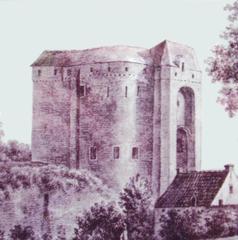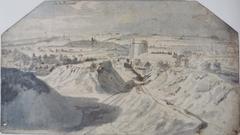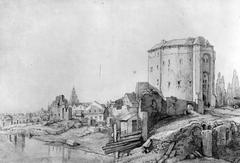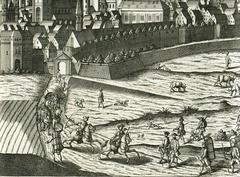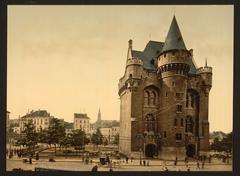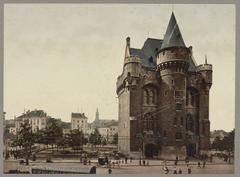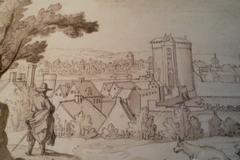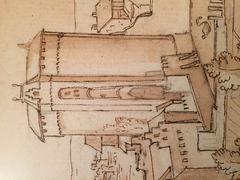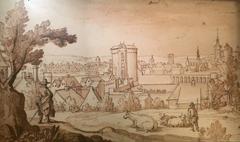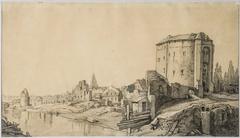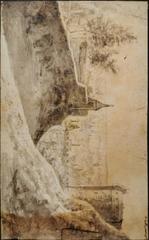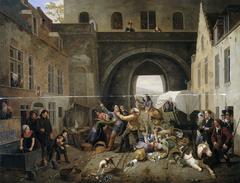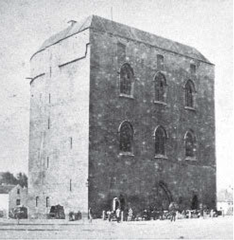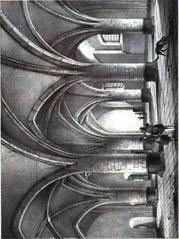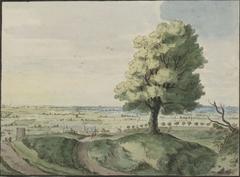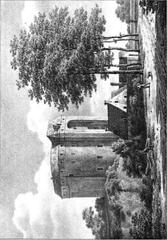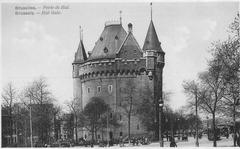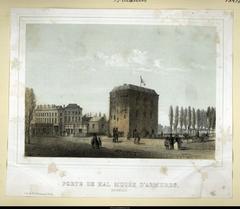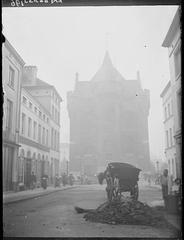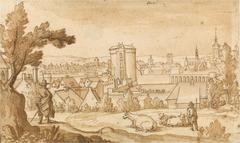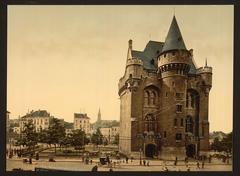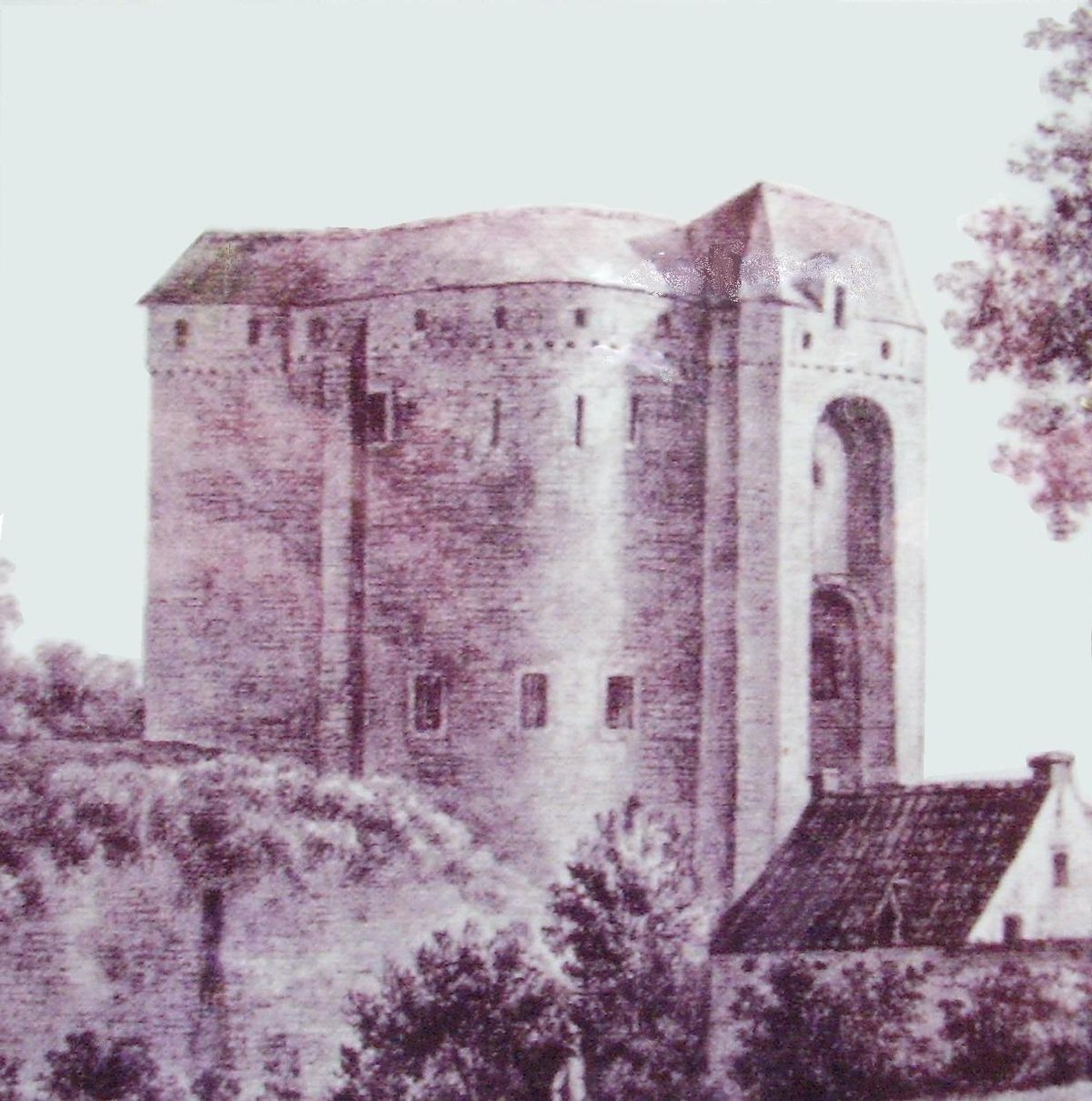
Halle Gate Visiting Hours, Tickets, and Guide to Brussels’ Historical Sites
Date: 14/06/2025
Introduction
The Halle Gate (French: Porte de Hal; Dutch: Hallepoort) is a striking symbol of Brussels’ medieval past and a must-visit for anyone interested in the city’s heritage. As the only surviving gate from Brussels’ 14th-century city walls, this monument offers a fascinating blend of military architecture, neo-Gothic restoration, and immersive museum experiences. Today, Halle Gate invites visitors to explore centuries of history, panoramic city views, and interactive exhibitions that bring the story of Brussels to life (hallegatemuseum.be; Spotting History).
Table of Contents
- Introduction
- Medieval Origins and Construction
- Architectural Evolution and Restoration
- Roles Through the Ages
- Museum Transformation
- Visiting Halle Gate: Hours, Tickets, and Accessibility
- Exhibitions and Highlights
- Practical Visitor Information
- Nearby Attractions and Travel Tips
- Guided Tours and Educational Activities
- Facilities and Amenities
- Frequently Asked Questions (FAQ)
- Conclusion and Call to Action
- References and Further Reading
Medieval Origins and Construction
Built between 1381 and 1383, the Halle Gate was one of seven monumental gateways in Brussels’ second city wall. Its original function was both defensive and economic, controlling access from the south via the road to Halle and serving as a customs checkpoint. The robust stone structure, with thick walls, a portcullis, and defensive towers, exemplified late medieval military architecture and projected the city’s wealth and power (hallegatemuseum.be).
Architectural Evolution and Restoration
As military technology evolved, so too did the Halle Gate. By the 16th and 17th centuries, innovations in artillery led to the addition of ditches and bastions, but eventually rendered the city walls obsolete. The gate survived while most fortifications were demolished during urban expansion in the 18th and 19th centuries, thanks to its adaptability and early preservation efforts.
In the 19th century, architect Henri Beyaert restored the gate in a neo-Gothic style, adding decorative turrets, battlements, and a steep slate roof. This romantic revival enhanced the building’s fairy-tale appearance while preserving its medieval core (Spotting History; Brussels.info).
Roles Through the Ages
Beyond its defensive origins, the Halle Gate played many roles: customs post, granary, archive, prison, and even a shelter. Its use as a prison lasted into the early 19th century, after which it narrowly escaped demolition. Advocacy by preservationists led to its protection by royal decree and eventual transfer to the Belgian state, ensuring its future as a public monument (hallegatemuseum.be).
Museum Transformation
The Halle Gate opened as a museum in 1847, following renovations led first by Tieleman Franciscus Suys and later by Beyaert. Today it houses the Royal Museums of Art and History’s collection on medieval Brussels, featuring armor, weapons, guild artifacts, and historical models. The museum also offers temporary exhibitions and family-friendly workshops (hallegatemuseum.be; belgium-travel.com).
Visiting Halle Gate: Hours, Tickets, and Accessibility
Opening Hours:
- Monday–Thursday: 09:30–17:00
- Saturday–Sunday: 10:00–17:00
- Closed Fridays and on 1 January, 1 May, 1 November, 11 November, and 25 December
- Early closure at 15:00 on 24 and 31 December (last entry at 14:00) (whichmuseum.com)
Ticket Prices:
- Adults: €10
- Seniors (65+): €8 (with ID)
- Students: €6 (with ID)
- Children/youth (18 and under): Free
- Visitors with disabilities: €6
- Brussels Card/museumPASSmusées holders: Free
- Special rates for educators, guides, certain benefit holders (belgium-travel.com; whichmuseum.com)
Purchasing Tickets:
- Tickets are available at the museum or online via the official website. Advance booking is recommended for groups and during peak times.
Accessibility:
- The museum is partially accessible. A lift is available for visitors with reduced mobility, but the panoramic terrace is only accessible by stairs.
- Free cloakroom lockers for personal items (Halle Gate FAQ).
Exhibitions and Highlights
Permanent Collection
- Medieval Weaponry and Armor: Swords, crossbows, and armor reflecting Brussels’ military heritage.
- Guild Artifacts: Objects representing medieval trade and craftsmanship.
- Historical Models and Maps: Models of Brussels and its fortifications.
- Multimedia Presentations: Films and digital reconstructions bring the past to life. (whichmuseum.com)
Interactive and Family Activities
- Replica medieval workshops and hands-on displays.
- Family workshops and themed events, especially during festivals (visit.brussels).
Panoramic Views
Climb 169 steps for a breathtaking panoramic view over Brussels’ skyline—a highlight for photographers and architecture fans (belgium-travel.com).
Practical Visitor Information
Address: Boulevard du Midi 150 (Zuidlaan 150), 1000 Brussels
Getting There:
- Metro: Lines 2 and 6, stop at ‘Porte de Hal’
- Tram: Lines 3, 4, 51, 81, 82
- Bus: Lines 48, 365A
- Train: Brussels South (Midi) station is a 10-minute walk
- Car: Paid parking available nearby (Halle Gate FAQ)
Facilities:
- Restrooms and free cloakroom lockers.
- No café or restaurant inside; the lively Saint-Gilles district nearby offers many dining options (visit.brussels).
- Outdoor medieval-themed playground 100 meters from the museum—ideal for families.
Nearby Attractions and Travel Tips
- The Marolles District: Famous for flea markets and antiques.
- Royal Museums of Art and History, Autoworld, Musical Instruments Museum: All nearby and easily combined with a visit to Halle Gate.
- Saint-Gilles: Explore Art Nouveau architecture, local bistros, and lively squares (visit.brussels).
Travel Tips:
- Wear comfortable shoes for stairs.
- Visit early to avoid crowds.
- Check the weather for panoramic terrace access.
- Light luggage is recommended; large bags go in lockers.
Guided Tours and Educational Activities
- Guided Tours: Available for individuals and groups; book in advance via the official form.
- Workshops: Educational activities focused on medieval history and architecture.
- Languages: Tours available in multiple languages.
Facilities and Amenities
- Restrooms and cloakroom with free lockers.
- No on-site café, but many options nearby.
- Themed outdoor playground close to the museum.
Frequently Asked Questions (FAQ)
Q: Is Halle Gate suitable for children?
A: Yes, interactive exhibits and a nearby playground make it family-friendly.
Q: Is the museum accessible for wheelchairs?
A: The main exhibition spaces are partially accessible via lift, but the panoramic terrace is only accessible by stairs.
Q: How long does a typical visit last?
A: About 90 minutes.
Q: Can I take photos inside?
A: Yes, but flash and tripods may be restricted.
Q: Are guided tours available in English?
A: Yes, check availability when booking.
Conclusion and Call to Action
Halle Gate is a unique testament to Brussels’ medieval legacy, blending defensive architecture, romantic restoration, and a vibrant museum experience. Whether you’re drawn to history, architecture, or panoramic cityscapes, your visit promises insight and inspiration.
Plan your trip today:
- Visit the official website for tickets and updates.
- Download the Audiala app for interactive guides and exclusive content.
- Follow Halle Gate and Brussels’ tourism channels for the latest events and travel tips.
References and Further Reading
- Halle Gate Museum History (hallegatemuseum.be)
- Spotting History – Halle Gate (Spotting History)
- Brussels.info – Halle Gate (Brussels.info)
- Belgium Travel – Halle Gate (belgium-travel.com)
- Visit Brussels – Halle Gate (visit.brussels)
- Whichmuseum – Halle Gate (whichmuseum.com)
